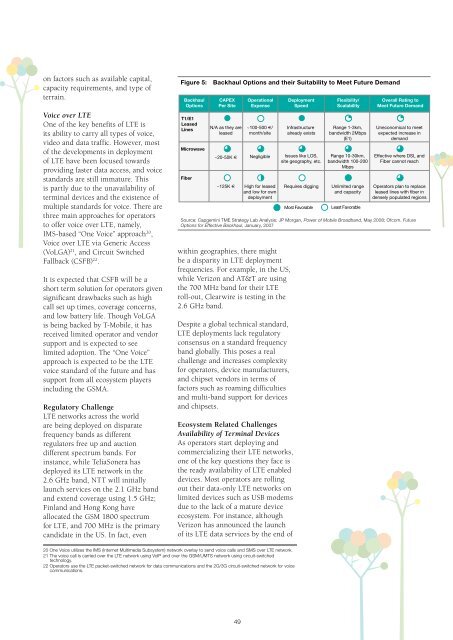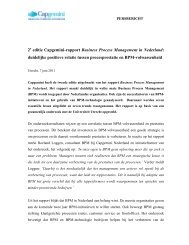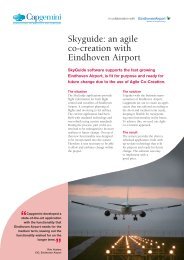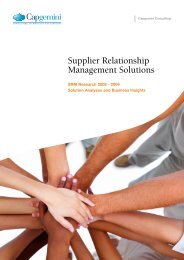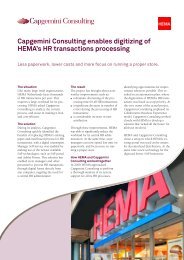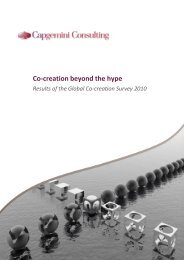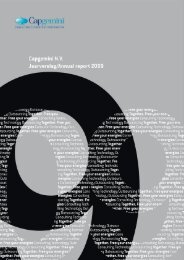IT transformations - Capgemini Consulting Nederland
IT transformations - Capgemini Consulting Nederland
IT transformations - Capgemini Consulting Nederland
You also want an ePaper? Increase the reach of your titles
YUMPU automatically turns print PDFs into web optimized ePapers that Google loves.
on factors such as available capital,<br />
capacity requirements, and type of<br />
terrain.<br />
Voice over LTE<br />
One of the key benefits of LTE is<br />
its ability to carry all types of voice,<br />
video and data traffic. However, most<br />
of the developments in deployment<br />
of LTE have been focused towards<br />
providing faster data access, and voice<br />
standards are still immature. This<br />
is partly due to the unavailability of<br />
terminal devices and the existence of<br />
multiple standards for voice. There are<br />
three main approaches for operators<br />
to offer voice over LTE, namely,<br />
IMS-based “One Voice” approach 20 ,<br />
Voice over LTE via Generic Access<br />
(VoLGA) 21 , and Circuit Switched<br />
Fallback (CSFB) 22 .<br />
It is expected that CSFB will be a<br />
short term solution for operators given<br />
significant drawbacks such as high<br />
call set up times, coverage concerns,<br />
and low battery life. Though VoLGA<br />
is being backed by T-Mobile, it has<br />
received limited operator and vendor<br />
support and is expected to see<br />
limited adoption. The “One Voice”<br />
approach is expected to be the LTE<br />
voice standard of the future and has<br />
support from all ecosystem players<br />
including the GSMA.<br />
Regulatory Challenge<br />
LTE networks across the world<br />
are being deployed on disparate<br />
frequency bands as different<br />
regulators free up and auction<br />
different spectrum bands. For<br />
instance, while TeliaSonera has<br />
deployed its LTE network in the<br />
2.6 GHz band, NTT will initially<br />
launch services on the 2.1 GHz band<br />
and extend coverage using 1.5 GHz;<br />
Finland and Hong Kong have<br />
allocated the GSM 1800 spectrum<br />
for LTE, and 700 MHz is the primary<br />
candidate in the US. In fact, even<br />
Figure 5: Backhaul Options and their Suitability to Meet Future Demand<br />
Backhaul<br />
Options<br />
T1/E1<br />
Leased<br />
Lines<br />
Microwave<br />
Fiber<br />
CAPEX<br />
Per Site<br />
N/A as they are<br />
leased<br />
~20-50K €<br />
~125K €<br />
Operational<br />
Expense<br />
~100-500 €/<br />
month/site<br />
Negligible<br />
High for leased<br />
and low for own<br />
deployment<br />
Deployment<br />
Speed<br />
Infrastructure<br />
already exists<br />
Issues like LOS,<br />
site geography, etc.<br />
Requires digging<br />
Most Favorable<br />
Flexibility/<br />
Scalability<br />
Range 1-3km,<br />
bandwidth 2Mbps<br />
(E1)<br />
Range 10-30km,<br />
bandwidth 100-200<br />
Mbps<br />
Unlimited range<br />
and capacity<br />
Least Favorable<br />
Overall Rating to<br />
Meet Future Demand<br />
Uneconomical to meet<br />
expected increase in<br />
demand<br />
Effective where DSL and<br />
Fiber cannot reach<br />
Operators plan to replace<br />
leased lines with fiber in<br />
densely populated regions<br />
Source: <strong>Capgemini</strong> TME Strategy Lab Analysis; JP Morgan, Power of Mobile Broadband, May 2008; Ofcom, Future<br />
Options for Effective Backhaul, January, 2007<br />
within geographies, there might<br />
be a disparity in LTE deployment<br />
frequencies. For example, in the US,<br />
while Verizon and AT&T are using<br />
the 700 MHz band for their LTE<br />
roll-out, Clearwire is testing in the<br />
2.6 GHz band.<br />
Despite a global technical standard,<br />
LTE deployments lack regulatory<br />
consensus on a standard frequency<br />
band globally. This poses a real<br />
challenge and increases complexity<br />
for operators, device manufacturers,<br />
and chipset vendors in terms of<br />
factors such as roaming difficulties<br />
and multi-band support for devices<br />
and chipsets.<br />
Ecosystem Related Challenges<br />
Availability of Terminal Devices<br />
As operators start deploying and<br />
commercializing their LTE networks,<br />
one of the key questions they face is<br />
the ready availability of LTE enabled<br />
devices. Most operators are rolling<br />
out their data-only LTE networks on<br />
limited devices such as USB modems<br />
due to the lack of a mature device<br />
ecosystem. For instance, although<br />
Verizon has announced the launch<br />
of its LTE data services by the end of<br />
20 One Voice utilizes the IMS (Internet Multimedia Subsystem) network overlay to send voice calls and SMS over LTE network.<br />
21 The voice call is carried over the LTE network using VoIP and over the GSM/UMTS network using circuit-switched<br />
technology.<br />
22 Operators use the LTE packet-switched network for data communications and the 2G/3G circuit-switched network for voice<br />
communications.<br />
49


